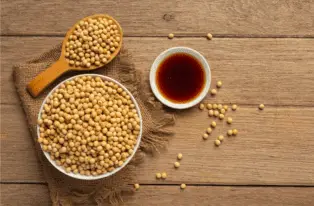 |
| The Health Benefits of Soy Sauce |
What is soy sauce?
It, also called soybean paste, soybean sauce, or by the Chinese name shuvo or shuvo (涼 油 or 醤 油), and numerous other names.
Soy sauce is a liquid condiment of Chinese origin, traditionally spice made from fermented soybeans, roasted grains (usually wheat), brine, salt water, Aspergillus oryzae, or Aspergillus sojae molds with salt and sometimes other ingredients added for flavor.
Soy sauce may have some health benefits. Is soy sauce healthy? To know more read, on here;
History of Soy Sauce-
Soy sauce has long been used in Chinese and Japanese cuisine for 2,000 years and has been a staple of many other cultures since the 19th century, including Korean, Vietnamese and Thai. In addition to being added to flavor foods, it also functions as a preservative. The word soy comes from shōyu (醤油), which itself comes from shoyu (醤油), meaning salty liquor in Japanese, and originated from southern coastal regions of China.
It came into use in China around the 5th century BC and the 7th century AD; soy sauce introduces in Japan. In Fukuoka Prefecture on Kyushu Island, Shōyu prepares. It wasn’t until 1665 that soy sauce started to be called by its current name!
shōyu when Lord Toshihito presented his brewed shōyu at Emperor Go-Yōzei’s court banquet. It has become increasingly popular in Western cuisine since around the early 1990s. Fermented soy products have long been a part of traditional Chinese medicine, where people think soya sauce boosts the immune system and protects against cancer.
How Is Made?
Wheat is usually mixed with soybeans and salted fermented mash to make spices. However, it made other grains such as barley, millet, sorghum, corn, and rice. The mixture is in barrels before being filtered to produce soy sauce. Read on to learn more about how is soy sauce made.
To make soy sauce, you must start with some starch sources. Traditionally, that starch was rice; however, many producers now use wheat because it is cheaper than rice and easier to store. Once the starch source is selected, mix it with a mold called Aspergillus oryzae (or A. sojae). This mold produces enzymes that break down complex carbohydrates into simple sugars.
Where Does Come From?
Soybeans, wheat, and salt combine to make soy sauce. The ingredient that gives soy sauce its distinctive salty flavor is amino acids (the building blocks of protein). Soy sauce is a common ingredient in Chinese, Japanese and Korean cooking. It adds a sweet and salty flavor to dishes such as tofu, eggs, noodles, and chicken. Used are soy sauces of different varieties as condiments in soups, stews, stir-fries, and other Asian dishes.
It is a delicious and flavorful condiment; which added to Asian dishes. It makes mostly from fermented ingredients. A typical bottle of sauce contains a large amount of sodium, making it very high in salt content.
However, not all brands contain as much sodium as others. If you eat a lot of salt but want to maintain the taste of your food without consuming too much sodium, look for low-sodium options.
Nutritional Facts –
Indefinitely Soy sauce will keep if stored in a cool, dark place.
- It is a source of healthy nutrients, including potassium and fiber.
- It is a good source of protein and vitamin B12.
- It is also a good source of minerals magnesium and zinc.
- Researchers believe that soy sauce’s beneficial effects may be due to its high levels of flavonoids.
- It is also a good source of plant-based omega-3 fatty acids.
- It contains high levels of soy isoflavones, which are antioxidants and have health benefits.
- It is low in calories and fat.
- It has high levels of sodium.
- It has high levels of protein.
- It contains high levels of calcium.
- It contains high levels of potassium.
Health Benefits –
It is considered a part of many traditional Asian cuisines, and it can help add flavor to your favorite dishes. In Chinese medicine for centuries, it has also used as a condiment been. But are there any health benefits to eating soy sauce? For example, does soy sauce have any nutrients that can benefit your health? Or should you avoid it altogether? Keep reading to learn more about what it can do for your body.
The most notable nutrient found in soy sauce is sodium. According to the U.S. Food and Drug Administration (FDA), adults should consume no more than 2,300 milligrams (mg) of sodium each day—and without adding extra salt from sauces like soy sauce on top of your usual meals!
A single tablespoon of Kikkoman Soy Sauce contains between 410-460 mg of sodium! So why would you ever want to eat something with such high levels of sodium?
The main reason people choose to use soy sauce is that it adds flavor to their favorite dishes. But there are many other ways to add flavor to a portion of food without using unhealthy condiments like soy sauce.
For example, some sauces and marinades that don’t contain any sodium include ginger, garlic, orange juice, and vinegar.
Although many health experts warn against overeating sauce because of its high amount of sodium, research has found that confirmed components in soy sauce may have pleasant effects on your health!
The Amazing Health Benefits –
It has a long history of being used as a seasoning and condiment. Soy sauce is not just a tasty addition to your food. It also has some surprising health benefits.
A study published in the journal Circulation found that people who regularly consumed soy sauce had a 43% lower risk of developing heart disease than those who didn’t eat sauce.
Studies have found that it has protective effects against certain cancers such as prostate cancer. It has associated with cancer-fighting properties.
There are many different types of soy sauce, each with its unique cancer-fighting properties.
- May help reduce the risk of stroke-
- Prevents heart disease-
- Protects against Cancer-
- May help improve your memory-
- May help reduce your risk of Alzheimer’s-
- Can help improve digestion-
- Helps prevent blood clots-
- Better the quality of blood-
- Control lower cholesterol-
- Can also help lower the risk of other chronic diseases-
- Has anti-inflammatory properties-
- Can also protect the liver-
- Can help prevent diabetes-
- Improves lower blood pressure-
- Helps you lose weight-
- Prevents osteoporosis-
- Can even help improve bone health-
- Can help protect your cells from damage.
- Can also help boost the immune system.
It is a popular condiment in many Asian dishes. It is made from fermented soybeans and is high in sodium. Fermenting means that enzymes in bacteria have changed protein into new chemicals called metabolites. Some of these are similar to chemicals your body makes that can help reduce cholesterol levels.
Although it is generally safe to consume, there are some risks associated with soy sauce consumption. These health benefits are possible side effects of eating soy sauce.
However, many processed foods contain soy sauce as a flavoring ingredient. If you are trying to lose weight by cutting calories and fat, adding extra sodium; and soy sauce may not be a good idea.
The American Heart Association prescribes restricting sodium admission to 1,500 mg each day. A single tablespoon of sauce contains 667 mg of sodium—almost half your daily limit!
But there are some ways you can enjoy sauce without overdoing it on salt. One study found that eating more than 2 grams of sodium is a 33% higher risk for stroke among people 45 years.
One of the risks is the high sodium content. It is very high in sodium, and consuming too much can lead to high blood pressure, stroke, and other health problems. If you are on a low-sodium diet or have high blood pressure, you should limit your use of soy sauce.
Another risk is allergies. Some people are allergic to soy, and consuming sauce can cause symptoms such as hives, wheezing, and difficulty breathing. If you are allergic to sauce, avoid other soy products.
How can you enjoy soy sauce more healthily?
Use low-sodium – There are many brands of low-sodium soy sauce on the market. When buying soy sauce, check the nutrition label to see how much sodium is in each serving.
Limit your intake- If you are using soy sauce, be mindful of how much you use. A little goes a long way, so you do not need to douse your food in soy sauce.
Try another sauce- There are many other sauces on the market instead of soy sauce.
Here are three ways to use less soy sauce when cooking –
Use equal parts water and soy sauce instead of just using sauce. Add spices such as fresh ginger, garlic, chili peppers, or lime juice to give flavor instead of relying on salty ingredients alone. Add low-sodium broth or water instead of high-sodium chicken broth when making soups and stews.
For example, you could add vegetable broth instead of chicken broth when making ramen noodles soup at home. You could also try adding miso paste to recipes instead of soy sauce.
Miso pastes-
Miso pastes make from fermented soybeans, but unlike sauce, it doesn’t contain any added salt. It does still provide plenty of umami flavor, though!
You can find miso paste at most grocery stores either in their refrigerated section or near other Asian ingredients. Make sure you buy white miso since brown miso has aged longer and has more intense flavors than white miso. One thing to note about sauce is that it often contains gluten.
Gluten –
Gluten is a protein found in wheat, rye, and barley. People with celiac disease cannot eat gluten because they develop an immune response to it.
How Can I Use in My Diet?
Because of its high salt content, soy sauce is a popular ingredient in Asian cuisine. This condiment has various uses, such as adding flavor to noodle dishes and stir-fries. But is it healthy? Does it have any benefits? And can you use it as a marinade or dressing for salads or side dishes at all?
Let’s look at everything you need to know about sauce and how to use it. It contains small amounts of vitamins and minerals and also large amounts of sodium. If you are trying to limit your sodium intake, overeating it may cause adverse effects on your health—especially if you consume large quantities regularly.
It does not seem to affect blood pressure levels; however, it does appear to lower good cholesterol levels in some people.
In addition, soy sauce may increase the risk of stomach cancer in those who eat a lot of it regularly.
However, studies show that fermented soy products like miso and tempeh do not increase cancer risk. No evidence suggests that regular consumption of fermented soy products increases breast cancer risk either. There is some evidence that consuming these foods reduces breast cancer risk.
The American Cancer Society notes that; research before conclusions about soy’s role in preventing or causing cancer. It does antioxidants and phytochemicals, which help protect against certain types of cancers and other diseases.
However, because it is from fermented soybeans, soy sauce does contain goitrogens—compounds that block thyroid function by interfering with iodine uptake by the thyroid gland.
How Much Should I Consume Daily; if I am Not Vegan or Vegetarian?
A small amount uses soy sauce as a condiment. It’s best to have just a little bit with your meal. But it contains high levels of sodium, which can increase your risk of hypertension and heart attack if you consume too much. If you’re not on a vegan or vegetarian diet, keep your daily consumption below two grams of soy sauce, approximately three teaspoons.
For those following a plant-based diet, it’s best to avoid consuming soy sauce altogether. In addition to containing a high amount of sodium, soy sauce may contain other harmful additives such as MSG.
I decided to use sauce occasionally and choose one that has been fermented naturally rather than chemically treated. It will ensure that it contains fewer chemicals and preservatives.
Also, purchase organic brands whenever possible; these are less likely to contain GMOs or harmful additives like gluten.
You should try to find a brand that doesn’t include wheat, corn, sugar, salt, alcohol, hydrogenated oils, or artificial colors.
Some brands use only natural ingredients like water and sea salt.
Different varieties of soy sauces are available at most grocery stores, so read labels carefully before purchasing!
How Do I Make This Fit Into My Diet Program if I’m Trying to Lose Weight Fast – Without Sacrificing Taste/Flavor in My Meals/Foods & Drinks?
If you’re trying to lose weight fast, you don’t want to necessarily; give up flavor and taste in your meals, and there are numerous ways that soy sauce can fit into a healthy diet.
For example, if you’re at a Chinese restaurant, try ordering your dishes without salt (many restaurants will also have lower-sodium soy sauce available). Or look for products with a sodium content of less than 20 percent per serving.
The Center for Science in the Public Interest recommends choosing low-sodium varieties of packaged foods, fresh meats, fish, and poultry. And remember that too much sodium can cause bloating and water retention—which may lead to weight gain! If you’re going to use soy sauce in cooking, it is best to use light-colored sauces with no more than 140 milligrams of sodium per tablespoon.
You should also avoid overly salty processed foods like soups and frozen dinners, which often contain excessive amounts of added salt.
Hi there! I’m content writer and blogger. With over two years of experience, I’ve shared my passion for writing across various platforms. I firmly believe in the transformative power of words and look forward to sharing this journey with you. Enjoy my work!










